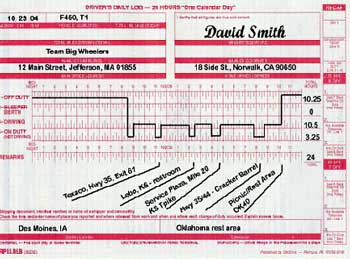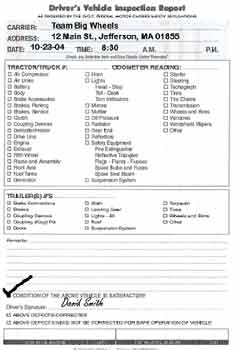Part 2 – Requirements for Drivers
Qualification
Drivers must have a current license permitted for the size vehicle being driving. CDL licenses require that the driver be 21 years of age, can read and speak English and pass a physical examination (questionairre DL546). Examinations very by state but all have a minimum list of requirements that need to be met. Department of Motor Vehicle websites of each state provide medical exam forms. These forms and the medical examiners certificate must be filled in by the doctor performing the exam. The certificate must be carried by the driver of any commercial vehicle at all times to prove that they passed the exam, even if they do not hold a commercial license. The certificates are only good for two years, thus new exams must be taken prior to their expiration.
Driving Licenses
Drivers are allowed to operate and tow the following based on each level or class of driving license:
- C – a holder of a C license can operate a 2-axle vehicle with a GVWR of 26,000 lbs. or less, a 3-axle vehicle weighing 6,000 lbs. or less gross, and any housecar of 40′ or less in length. A holder of a C license can tow a single vehicle with a GVWR of 10,000 lbs. or less including the tow dolly, if used.
- C commercial – only used in conjunction with HAZMAT.
- B – a holder of a B license can operate any vehicles under Class C (non-commercial) and any housecar over 40′ but not over 45′, with endorsement.
- B commercial – a holder of a B commercial license can operate a single vehicle with a GVWR of more than 26,000 lbs., a 3-axle vehicle weighing over 6,000 lbs. gross, a bus (except a trailer bus) with endorsement, and all vehicles under Class C. This license holder may also tow a single vehicle with a GVWR of 10,000 lbs. or less.
- A – a holder of an A license may operate any vehicles under class C and any vehicles under B non-commercial. This holder may also tow travel trailers weighing over 10,000 lbs. GVWR when not used for hire and 5th-wheel travel trailers weighing over 15,000 lbs. when not used for hire.
- A commercial – a holder of an A commercial license may operate any legal combination of vehicles, including vehicles under Class B and Class C. This holder may also tow any single vehicle with a Gross Vehicle Weight Rating (GVWR) of more than 10,000 lbs., any trailer bus, with endorsement or more than one vehicle, with endorsement and any vehicles under Class B and C.
In California, a holder of a C license who is operating a vehicle weighing 4,000 lbs. or more unladen, may tow a trailer coach or 5th-wheel travel trailer exceeding 10,000 lbs. but not exceeding 15,000 lbs. GVWR, when towing is not for compensation and with endorsement. This is only good in California and does not meet the federal guidelines. Outside of California, this vehicle combination requires an A license.
No passenger vehicle regardless of weight, may tow more than one vehicle. Some exception apply, such as in Michigan, but this does not meet federal guidelines.
No motor vehicle under 4,000 lbs. unladen may tow any vehicle weighing 6,000 lbs. or more gross.
CDL
So, when does a driver need a commercial driving license or CDL? Any driver who will operate a motor vehicle or combination of vehicles designed or used for the transportation of persons or property for compensation and:
- Has a gross vehicle weight rating (GVWR) of 26,001 pounds or more.
- Tows any vehicle with a GVWR of 10,001 pounds or more.
- Tows more than one vehicle or a trailer bus.
- Has three or more axles (excludes three axle vehicles weighing 6,000 pounds or less gross).
- Is any vehicle (bus, farm labor vehicle, general public para-transit vehicle, etc.) designed, used, or maintained to carry more than 10 passengers including the driver, for hire or profit, or is used by any nonprofit organization or group.
Exceptions to the CDL requirements are:
- Drivers who tow a fifth-wheel travel trailer over 15,000 pounds GVWR or a trailer coach over 10,000 pounds GVWR, when the towing is not for compensation. Drivers must have a noncommercial Class A license.
- Drivers of housecars over 40 feet but not over 45 feet, with endorsement as long as the vehicle is not being used for commercial use.
Drivers Daily Log
 The purpose of the driver’s daily log is to ensure that the drivers comply with all DOT regulations during the operation of a commercial motor vehicle. Any driver traveling over a 100 air mile radius from their base of operation or for overnight travel must comply with DOT regulations and fill out proper driver logs. A driver’s daily log (example at right) must be filled out for each day of the trip and must be kept up to date for examination at weigh stations and inspections.
The purpose of the driver’s daily log is to ensure that the drivers comply with all DOT regulations during the operation of a commercial motor vehicle. Any driver traveling over a 100 air mile radius from their base of operation or for overnight travel must comply with DOT regulations and fill out proper driver logs. A driver’s daily log (example at right) must be filled out for each day of the trip and must be kept up to date for examination at weigh stations and inspections.
The upper section of the form should be simple to fill in as the only portions that change per day are the date and mileage. For reference, the carrier is the company or team that owns the vehicle and the home office address can be the local office where you work (not the main office) or the driver’s home address. Vehicle numbers are those designated by the carrier when filing for a DOT number.
The main component of the log is the 24-hour grid that runs from midnight to midnight. This grid is divided into the following 5 sections:
Off Duty: any time where the driver is not working or on duty. This includes any time spent at hotels or sleeping in rest areas.
 Sleeper Berth: this is time spent in an actual sleeper berth. This does not include time spent in a sleeping unit in a trailer as that would be considered off duty time.
Sleeper Berth: this is time spent in an actual sleeper berth. This does not include time spent in a sleeping unit in a trailer as that would be considered off duty time.
Driving: this is actual time spent driving.
On Duty (not driving): this is the amount of time spent fueling, loading, unloading, on repairs, and any time where the driver is waiting for the truck to be prepared for driving.
Remarks: this is the area where the driver is responsible for listing the locations where changes in the above sections occurred and the reason for the change.
Be sure to total the amount of time in each section of the grid and list these in the appropriate locations at the right. Inspectors tend to slap a driver on the hand for failing to fill in the upper section of the form but they will penalize a driver who does not fill in the totals. An example of the method for filling in the grip is shown in the form at the upper right. The driver must also list that day’s starting city and the name of the destination city. The destination city is the place where the current trip will end or where driver will cease for a period of time.
In addition to filling out the daily log the driver is responsible to fill out the pre-trip inspection section found on the back of the log (shown at right) or on a separate inspection form. If a defect is found the vehicle cannot be put in service until a mechanic has repaired the problem and signed off on the inspection form. This must occur each day of the trip where the vehicle is being driven.
Drivers are required to keep seven consecutive days of records to prove they are under the 60/70 hour rule (see Driving Times below). They are also required to send a copy of each record to their employer/carrier within 13 days. For days where the driver did not work, draw a line through the off-duty section and total it at 24 hours. For consecutive days off, do the same but list all dates in the lower Remarks section.
Exceptions: drivers who stay within a 100 air mile radius and return to the starting point within 12 hours can use a time card rather than a log book.
Driving Times
As of January 4, 2004, drivers of commercial vehicles may not drive:
- more than 11 hours following 10 consecutive hours off duty.
- after being on duty 14 hours following 10 consecutive hours off duty.
- After being on duty 60 hours any 7 consecutive days or 70 hours any 8 consecutive days. On duty status can resume for 7th or 8th day after the driver takes 34 consecutive hours off duty.
Drivers can add up to 2 hours for an on duty period once during a seven day period for adverse conditions (like rain or snow) as long as they don’t exceed the 14 hour on duty period. Drivers are no longer allowed break extensions for on duty time as the 14 hours is now calculated from the time they start. Drivers can combine sleeper and off time for the 10 hours off duty.
Drivers may split on duty time by using sleeper berth periods. These drivers may accumulate the equivalent of 10 consecutive hours off duty by taking 2 periods of rest in the sleeper berth, provided: Neither period is less than 2 hours; driving time in the period immediately before and after each rest period when added together does not exceed 11 hours; and the on-duty time in the period immediately before and after each rest period when added together does not include any driving after the 14th hour.
If a driver is on-duty, but not driving, on a particular day, the driver may remain on-duty for more than 14 hours; however, the driver cannot drive past the 14th hour after coming on-duty. Also, the additional on-duty time will reduce subsequent on-duty time available under the 60/70 hour rule.
